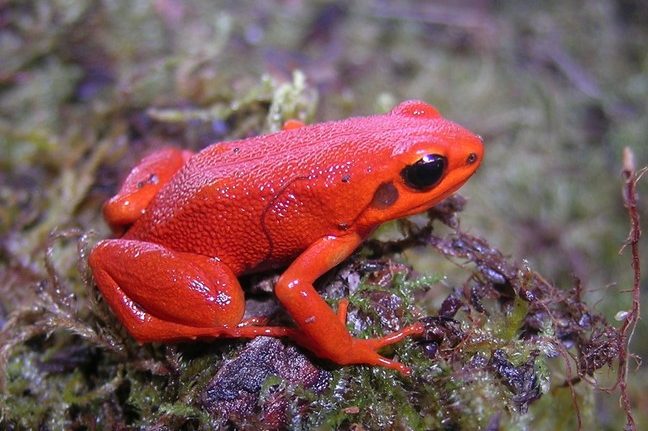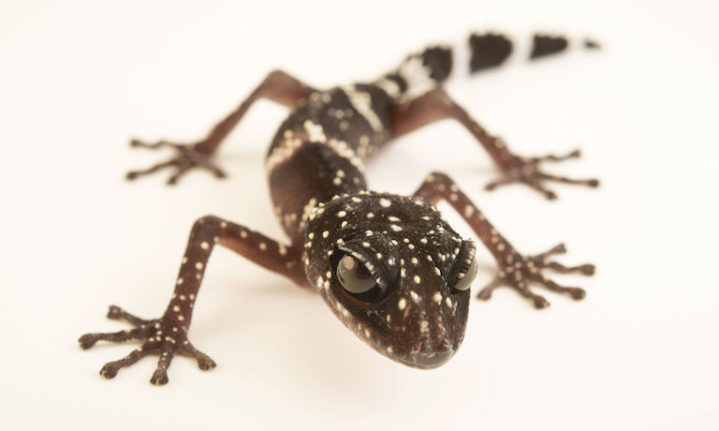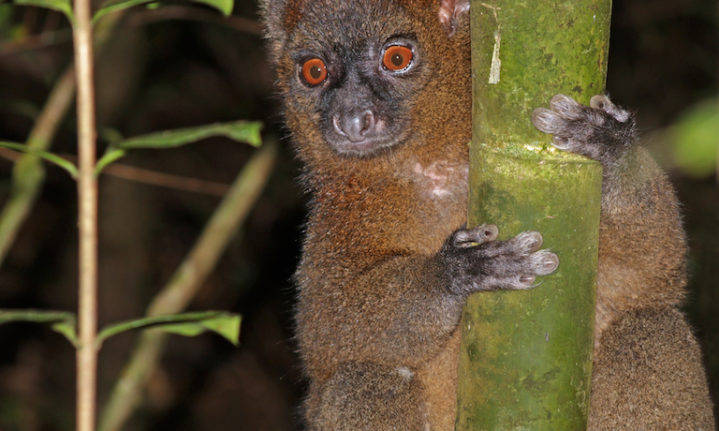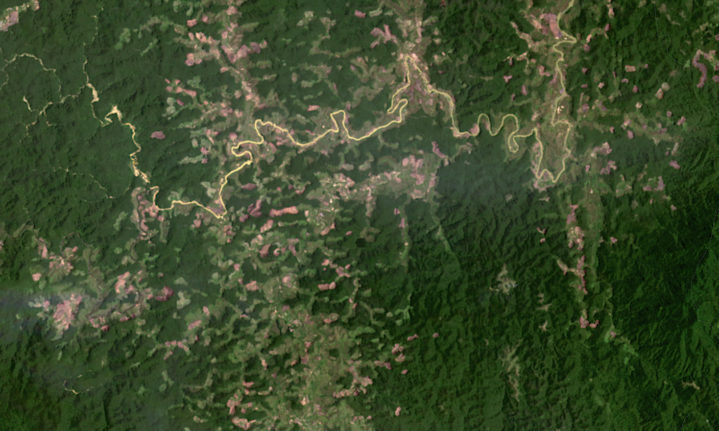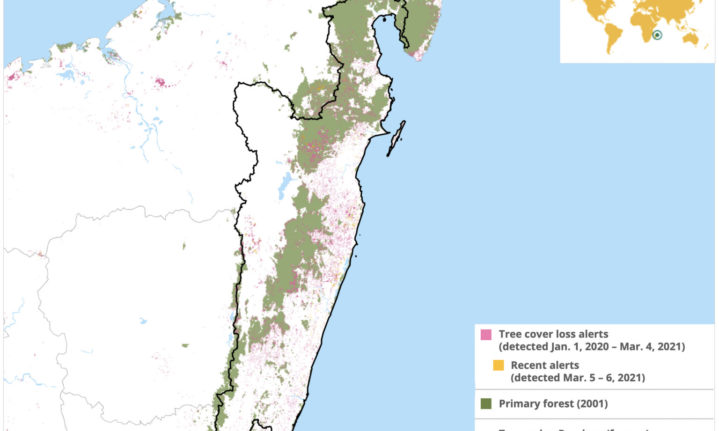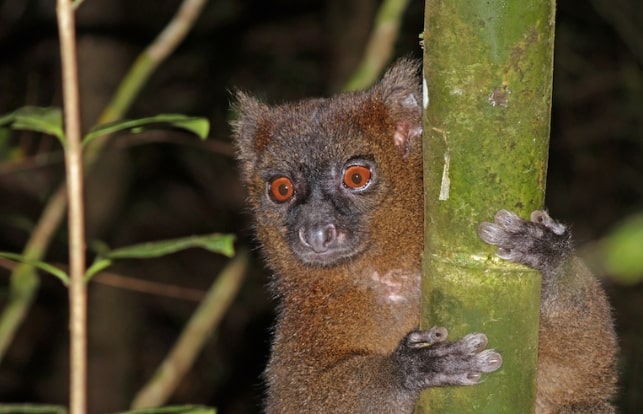Deforestation is so rampant throughout Madagascar, an island far larger than California, that it’s easy to forget the impact of tree clearance in any one specific area of the country — the lemurs that lose their habitats, the orchids that no longer bloom, the people whose land becomes barren. But recent activity in the Ankeniheny-Zahamena Corridor (CAZ), a large protected area in central eastern Madagascar, has raised concerns that one of the country’s most important tropical rainforests is being lost.
Over the past five months, CAZ has seen a number of spikes in deforestation activity, according to satellite data from the University of Maryland (UMD) visualized on Global Forest Watch. This isn’t a new problem — CAZ has faced high levels of tree clearance for several years — but preliminary data indicate that it’s getting worse.
Local sources say the forests are being lost primarily to swidden agriculture (slash-and-burn), a practice that can increase during times of economic difficulty. With less income during the pandemic, local people have sought to increase their rice yields by using more forestland.
The trend spells major trouble for the 15 lemur species that live in CAZ as well as endangered amphibians endemic to CAZ, such as the black-eared mantella frog (Mantella milotympanum), the Scaphiophryne boribory frog, and the Paroedura masobe gecko.
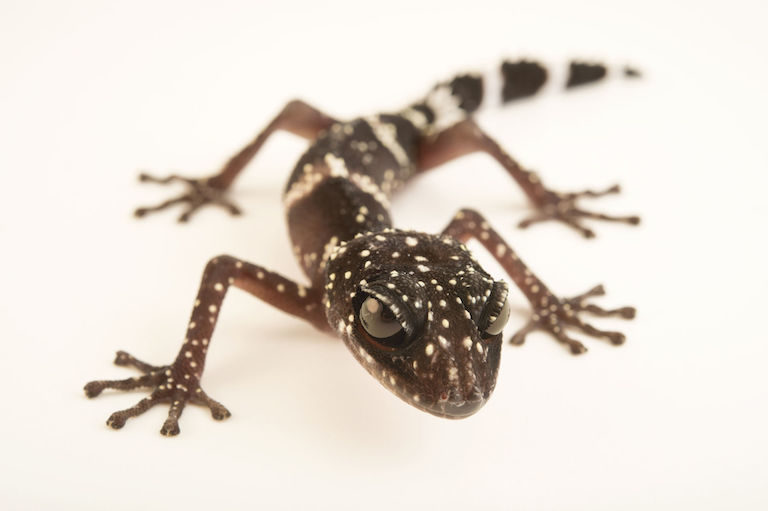
The masobe gecko (Paroedura masobe) is endangered and may only survive in CAZ. Image by Jaine via Wikimedia Commons (CC BY-SA 4.0).
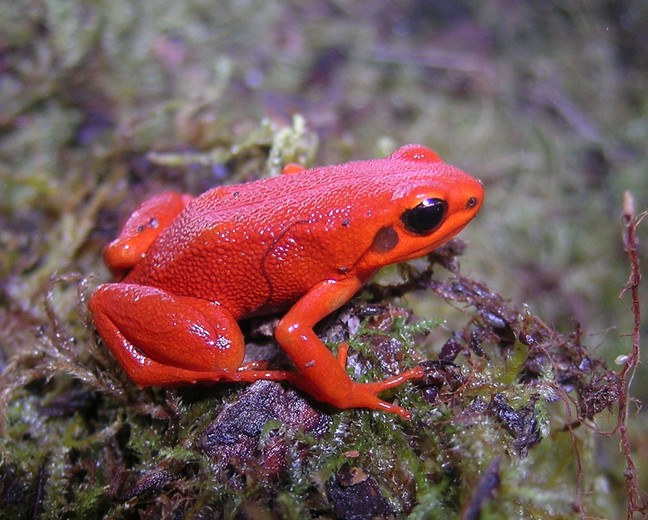
The black-eared mantella frog (Mantella milotympanum) is critically endangered. Its main threat is habitat loss. Image by Franco Andreone via Wikimedia Commons (CC BY-SA 2.5).
The consequences for the region’s ecosystems could be tragic, conservationists say.
“As habitat shrinks or gets increasingly fragmented you will always have effects on the entire ecosystem and its biodiversity (such as isolation, edge effects and inbreeding depression),” Rainer Dolch, coordinator of Association Mitsinjo, a conservation organization working in protected areas just south of CAZ, wrote in an email to Mongabay. “Severe deforestation would therefore definitely put the survival of [this] biodiverse ecosystem at risk.”
A crucial corridor
CAZ covers an area larger than the U.S. state of Rhode Island and is made up of medium-altitude rainforest, with more than three-quarters of its area lying between 750 and 1,250 meters in altitude (between 2,500 and 4,100 feet, roughly). CAZ is hugely biodiverse, with scores of plant species that live only there and in surrounding areas. There’s also a wide range of birds, tenrecs, and other animals, many of which are endangered.
In CAZ, as elsewhere, fires used to clear land for swidden agriculture are most common late in the dry season, just before the rain begins in November or so. In 2020, UMD picked up eight times the normal number of deforestation alerts during the final week of October, measured against a five-year baseline. And the baseline was already high: from 2015 to 2019, CAZ lost about 5,000 hectares (nearly 12,400 acres) — about 1.3% of its surface area — of tree cover per year, according to UMD data. Almost all of the lost forest was humid primary forest.
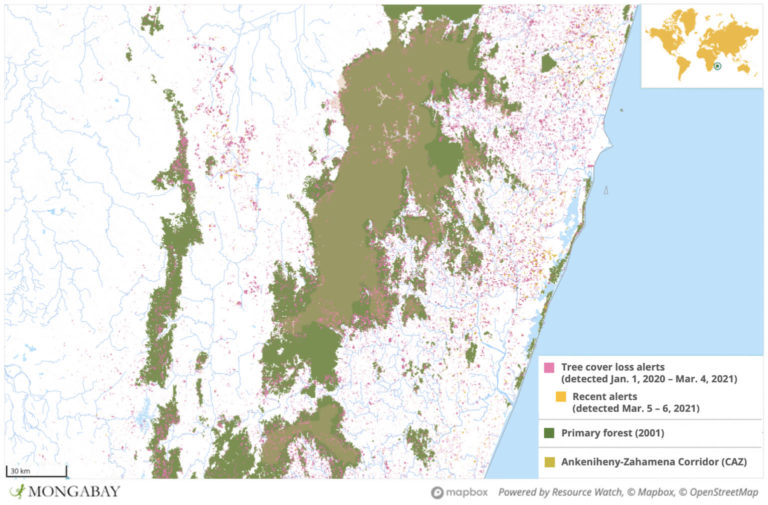
Satellite data from the University of Maryland show CAZ experienced a surge in deforestation in 2020.
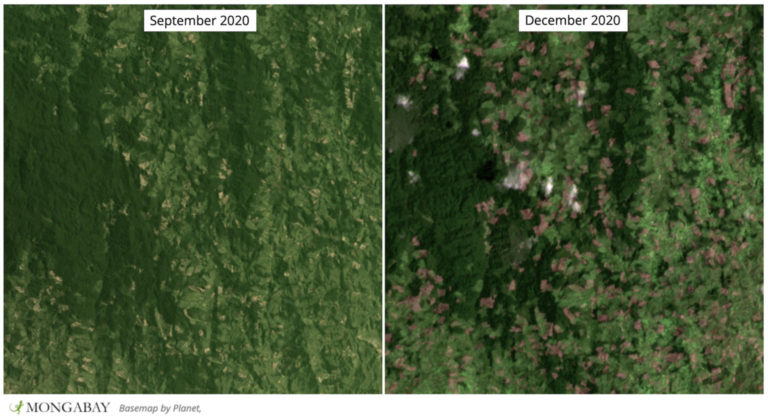
Satellite imagery shows rapid deforestation in CAZ in late 2020.
This is bad news for the four critically endangered lemur species that live in CAZ, including the greater bamboo lemur, which conservationists recently discovered there in 2010. CAZ turns out to be the species’ main home, with a recorded population size of about 600. But the giant bamboo that the species depends on is disappearing. Maholy Ravaloharimanitra, national representative for the Aspinall Foundation, which has worked on conservation in CAZ since 2009, says the greater bamboo lemur and other species will not survive if such high levels of deforestation continue.
“They will be wiped out with the forest because [currently] they are already struggling,” she told Mongabay.
It’s not just the edges of the forests that are threatened. Farmers also go into the interior of CAZ, including the “hard core” zones where all such activities are absolutely prohibited, to set fires and plant rice. They seek out low-lying areas near waterways that are ideal for irrigation purposes; outside of protected areas, such ideal farming spots are already taken.
Swidden agriculture isn’t the only problem in CAZ. Local people also cut down the trees to make charcoal, which has a high value in Madagascar as it’s used for cookfires. People in CAZ have become less and less selective in their logging because the demand for charcoal has risen in recent years, Ravaloharimanitra said.
Illegal mining, primarily for sapphires, is also a high-profile problem in CAZ. There has been a series of gemstone rushes over the past decade, the largest of which began in 2016 and lasted between one and two years, bringing thousands of migrant workers to the western section of CAZ and creating temporary shantytowns in the middle of the jungle. (The migrant workers were from other parts of Madagascar; the BBC estimated their number at 40,000, but estimates vary widely — CAZ’s remoteness makes it difficult to monitor.)
CAZ faced especially high levels of deforestation in 2017 and 2018, and the gemstone rush may have played a role. In addition to direct clearance for mining, there were knock-on effects caused by the increased population; new arrivals aren’t as concerned with conservation as long-term residents, Ravaloharimanitra said.
“They don’t respect anything, they don’t care about anything,” she said, referring to the migrants’ attitudes toward local conservation rules.
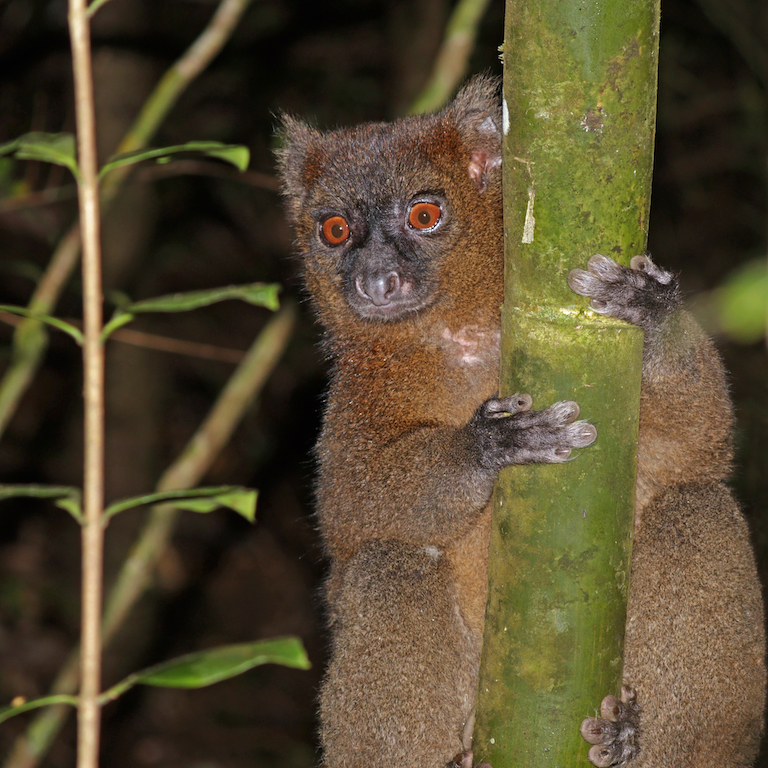
Greater bamboo lemur (Prolemur simus). Image by Charles J. Sharp via Wikimedia Commons (CC BY-SA 4.0).
The greater bamboo lemur (Prolemur simus) is one of the world’s most endangered primates. CAZ is the species’ most important remaining stronghold. Image by Charles J. Sharp via Wikimedia Commons (CC BY-SA 4.0).
The result has been increased pressure on CAZ’s forests. Rainer Dolch, the Mitsinjo coordinator, who’s lived and worked in the area for more than 25 years, said that he’s seen the changes himself.
“You can feel it just from the amount of smoke that’s in the air,” he said, explaining that he recently spent time in CAZ. “Places that were forest five or ten years ago are now void of vegetation.”
A management challenge
CAZ became a full-fledged protected area in 2015 after a decade in which it held a temporary status. (Parts of CAZ have been protected since the 1960s.) It’s one of many newer protected areas in the country that has a mixed-use model in which some natural resource use is allowed — a system meant to combine conservation goals with the needs of local people. Activity is completely prohibited in the interior “hard core” zones; in outer zones, it’s strictly regulated (if not always strictly enforced), with permits required for some resource use.
Conservation International, a Virginia-based NGO, has management responsibility for CAZ, per an agreement with Madagascar’s government. It helps facilitate local groups called Vondron’Olona Ifotany (VOI) that patrol sections of the forest and help with ecological monitoring. (This devolved system of authority is used in many of Madagascar’s protected areas.)
Confidence in the management system in CAZ has been weakened by rampant rumors of corruption, according to Ravaloharimanitra of the Aspinall Foundation. She says that district and regional officials, including representatives of the environment ministry, are seen by local people as corrupt. One problem is that officials issue logging permits in French, a language that many VOI members can’t read, which makes it difficult for VOIs to enforce conservation rules. Some loggers take advantage of this by engaging in activities that they have no permit for, or in locations where they’re not specifically allowed to log, she said. Meanwhile, those who break the rules are rarely subject to legal action, so there’s limited accountability. The cumulative effect is to leave local people disillusioned, wondering why their agricultural techniques remain prohibited while others flout the rules, she said. The environment ministry did not respond to a request for comment for this article.
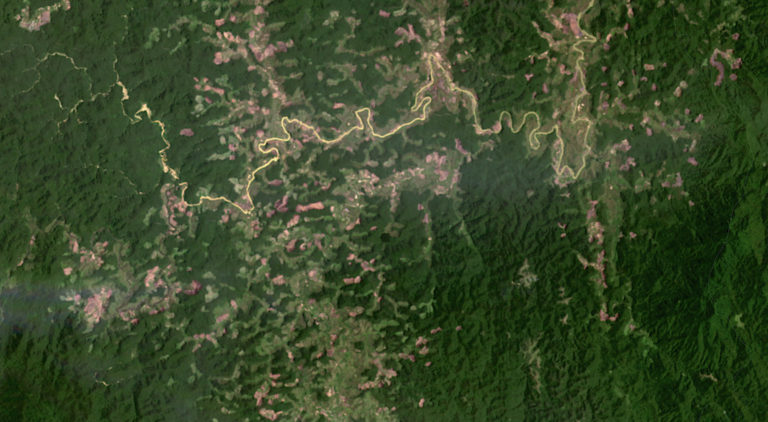
Satellite imagery captured in December 2020 shows many new clearings cutting into rainforest in CAZ. Image from Planet Labs.
Starting in 2012, CI ran a pilot REDD+ project in CAZ designed to help local people develop alternative livelihoods and preserve biodiversity and carbon, of which Madagascar’s tropical forests have significant amounts . REDD+ is a program through which high-income countries provide financial incentives to low-income tropical countries to keep their forests standing and thereby reduce deforestation-related carbon emissions. This particular project was one of many REDD+ pilot projects across the country. In a recent deal with the World Bank, Madagascar’s government committed to the next stage of REDD+ implementation.
Academics have criticized the REDD+ pilot program and, more broadly, the way CAZ was established. In a 2018 study in PeerJ, scientists found that conservation restrictions in CAZ had come at great cost to local people by declaring much of the forest off-limits and thereby limiting their access to resources. The authors concluded that a one-off payment that local people received was not nearly enough to compensate for the long-term loss of forest access caused by the creation of the protected area.
“[W]e show that the local people, some of the poorest in the world, have lost out as a result of the protected area establishment, and that compensation provided to mitigate these costs has been inadequate,” the authors write in the study. “Too little has been received by too few and it has not reached those most in need.”
Some 325,000 people live in villages and hamlets within CAZ, and they have to make use of land and resources to survive, for example by using wood to build and cook. In fact, 90% of them engage in swidden agriculture, according to the 2018 study. And so there are few easy solutions for conservation actors.
Bruno Rajaspera, director of community resources support at CI Madagascar, told Mongabay that CI uses a “landscape approach” in CAZ that incorporates economic, social and governance initiatives so that conservation can be achieved as part of a sustainable development agenda. He said that while CI does not yet have official data, he assumes that, as elsewhere in Madagascar, deforestation in CAZ went up in 2020 due largely to economic pressures caused by the pandemic. (As previously mentioned, UMD’s preliminary data show the increase in deforestation.)
Part of a larger trend
Deforestation in CAZ is part of a larger regional trend, one not confined to protected areas. The central eastern section of Madagascar, what was once called Toamasina province, has incurred massive tree cover loss over the last two decades. Between 2001 and 2019, it lost more than 1.5 million hectares (3.7 million acres, an area bigger than the U.S. state of Connecticut) of tree cover, more than a quarter of which was humid primary forest, according to satellite data visualized on Global Forest Watch. Most of this loss has come since 2013.

Satellite data show the area comprising the former province of Toamasina experienced a surge in deforestation in 2020
Researchers say this has put intense pressure on animal populations, including a variety of amphibians and reptiles endemic to the area, including golden mantella frogs (Mantella aurantiaca), cork-bark leaf-tailed geckos (Uroplatus pietschmanni) and Tarzan chameleons (Calumma tarzan).
Philip-Sebastian Gehring, a German herpetologist who described the Tarzan chameleon in a 2010 paper in Salamandra, told Mongabay that his team was lucky enough to find the species in a tiny forest fragment, but that many other species are being lost before scientists ever discover them, due to the dangerously high levels of deforestation.
Certain sections of Toamasina province have been particularly hard hit. The forests around Andilamena, a town roughly 80 kilometers (50 miles) north of CAZ, have been decimated, partly because of sapphire and ruby deposits discovered there over the last two decades. The activity has bled into a protected area just to Andilamena’s northeast: Ambatovaky, a special reserve made up of lowland and medium-altitude rainforest. In 2018, 1,900 hectares (4,700 acres) of forest were lost in Ambatovaky, amounting to 2.4% of the reserve’s surface area, according to Madagascar National Parks (MNP), a semi-public agency that manages the reserve. The deforestation rate dropped dramatically in 2019, a change that MNP attributed to increased conservation funding, but preliminary data indicate that deforestation again surged in Ambatovaky in the last year. Similarly, the unprotected Andilamena area has also seen severe deforestation in the past year, UMD’s satellite data show.
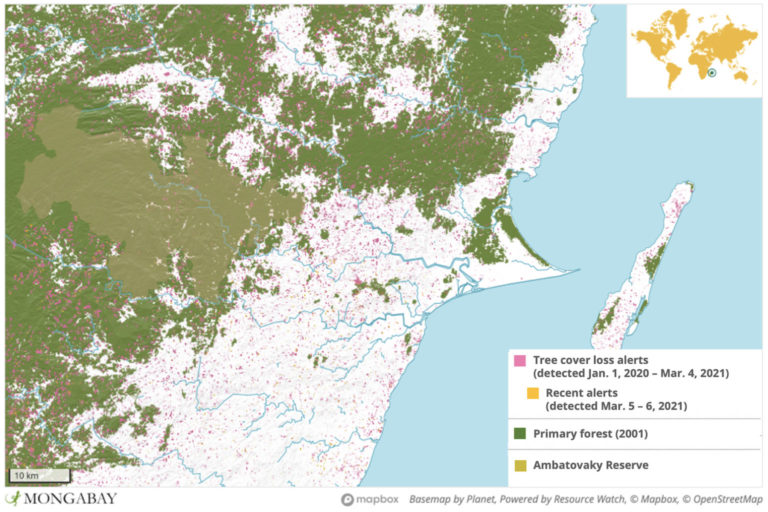
Satellite data from the University of Maryland show Ambatovaky experienced a surge in deforestation in 2020.
While deforestation is a regional and national problem — a 2018 study in Biological Conservation led by French researcher Ghislain Vielledent showed that Madagascar lost nearly half of its natural forest between 1953 and 2014 — it’s also a tragedy unfolding in specific places such as CAZ. Indeed, CAZ is the first deforestation hotspot Vielledent and his co-authors mention in the study. Three years on, the forest continues to be cleared and the future of life in CAZ hangs in the balance.
Citations:
Poudyal, M., Jones, J. P., Rakotonarivo, O. S., Hockley, N., Gibbons, J. M., Mandimbiniaina, R., … Ramamonjisoa, B. S. (2018). Who bears the cost of forest conservation? PeerJ, 6, e5106. doi:10.7717/peerj.5106
Gehring, P. S., Pabijan, M., Ratsoavina, F. M., Köhler, J., Vences, M., & Glaw, F. (2010). A Tarzan yell for conservation: A new chameleon, Calumma tarzan sp. n., proposed as a flagship species for the creation of new nature reserves in Madagascar. Salamandra, 46(3), 167-179. Retrieved from http://www.sebastiangehring.de/gehring_etal_2010_ctarzan.pdf
Vieilledent, G., Grinand, C., Rakotomalala, F. A., Ranaivosoa, R., Rakotoarijaona, J. R., Allnutt, T. F., & Achard, F. (2018). Combining global tree cover loss data with historical national forest cover maps to look at six decades of deforestation and forest fragmentation in Madagascar. Biological Conservation, 222, 189-197. doi:10.1016/j.biocon.2018.04.008









